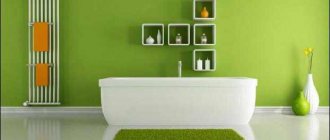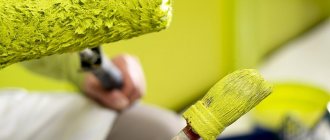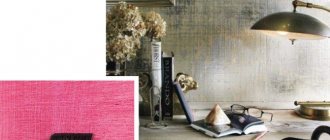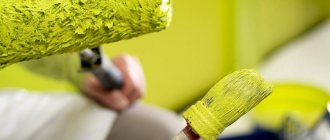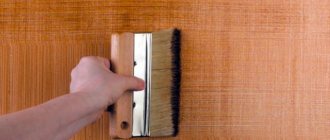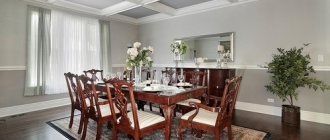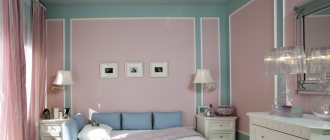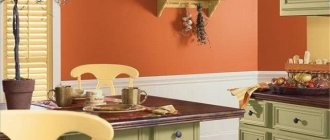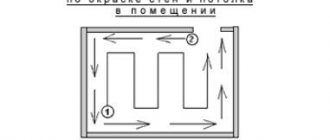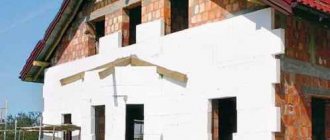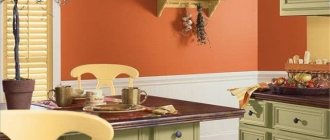| Preparation | Surface protection (covering windows, walls, ceilings) | 50 r/m² |
| Primer | Primer of walls | 50 r/m² |
| Ceiling primer | 60 r/m² | |
| Painting | Painting the walls | 150 RUR/m² |
| Painting the ceiling | 170 RUR/m² | |
| Technical painting of walls and ceilings in 1 layer | from 45 RUR/m² |
Real examples of our work:
This method is a mechanized application of paint to a surface using the dispersion method. Thus, the applied paints and varnishes form a special dense film, which not only gives an aesthetic appearance, but also protects the painted surface from external factors.
Airless painting technology uses air as a medium that reduces the spray rate.
The crushing of the coloring liquid is carried out without the participation of compressed air, which is why the method of painting with this equipment received this name.
Uniform application
The spray gun is also ideal for areas that are not ideal on their own, such as textured walls, textured ceilings or other 3D surfaces. You can use a paint machine to ensure that the paint is applied evenly, allowing you to get the best quality paint job for your room. Uniform application promotes faster drying of painted surfaces. You can significantly reduce your wait time after painting and then move on to the next stage of your renovation. And the above-mentioned absence of streaks from a brush or roller is a definite advantage.
Advantages of the modern dyeing method
The main advantage of airless painting is the ability to apply thick layers of coatings and use less solvents. There are no foreign particles or air in the coloring stream, due to which it is possible to obtain high-quality and uniform painting of surfaces. Spraying paint under high pressure in the apparatus helps reduce the cost of paint and varnish materials and reduces the labor intensity of work, which is especially important when painting large rooms and objects.
Equipment Features
In a spray gun for airless painting, unlike its pneumatic counterpart, there is no air in the output stream, although the equipment is very similar. The sprayer can be mounted on a portable stand for maximum convenience during airless painting. The equipment includes the following components:
- a fitting that supplies dye;
- body with handle;
- elliptical nozzle;
- compressor;
- special hoses.
Airless spraying must be carried out with high quality and reliable equipment. The sealing elements must be airtight. The device must have a safety shutter. A special anti-slip coating must be applied to the handle of the equipment.
Cheap spray bottles are made with plastic bodies. The durability of such devices raises a lot of doubts, since plastic is not highly durable and resistant to chemicals.
The best option is to use metal devices. If during work you have to move around in limited conditions, then it is better to opt for a compact model.
Airless spraying has important advantages:
- Mechanization of the painting process and increasing the speed of work.
- Obtaining a perfectly even coating with a soft application of the coloring composition.
- Eliminates the need for heavy ventilation due to reduced solvent use.
- Increased productivity of painting work and the ability to apply a thick layer of paint.
- Saving of paint compositions due to the large area of the spray flow.
- Increasing the sanitary and hygienic safety and environmental friendliness of the painting work performed.
Airless painting of walls and ceilings indoors
In order to reduce the time of painting work, as well as significantly reduce the cost of the service without compromising the quality of the work performed, most enterprises and individuals have recently preferred airless painting.
Airless painting is used mainly in the process of work on objects with large areas: retail spaces, hangars, warehouses, industrial facilities, etc. But this type of paint and varnish work is also applicable in residential premises - it significantly reduces repair time and improves quality work. Also, process automation allows you to reduce the total number of employees, reduces material costs and significantly saves the customer’s budget.
Undoubtedly, the equipment costs a lot, but it is much more advisable to turn to professionals who own high-tech equipment and experienced specialists. Our company’s employees will show you a result that will exceed all expectations in the shortest possible time.
The quality of the work performed directly depends on the quality of the selected equipment and paint - that is why you need to responsibly choose a company that will work on your site. These must be professionals in their field, armed with modern equipment and high-quality paints and varnishes.
To accurately determine the final cost of the work performed, you need to assess the volume and complexity. Thus, the cost of painting a square meter in an industrial space can cost much less than the same volume in an apartment. Moreover, when providing services to large companies, contractors often make concessions in the form of discounts.
Using airless painting machines
Airless painting equipment today is the most popular in industrial and civil use, at construction sites, during repair and restoration processes, as well as during the manufacture of various goods. The main advantages of painting machines of this type are high performance, wear resistance, fast painting, and affordable price. Today you can buy airless paint sprayers of a wide variety of models and brands. Their differences will lie in technical features, for example, the following: pressure power, size, weight of the main unit, transportation methods, and other indicators.
Our airless painting services include the following:
- Painting facades of industrial complexes and retail premises
- The use of industrial climbing in painting high-rise structures
- Painting walls in residential premises (houses, apartments), including walls covered with wallpaper for painting
- The cost of services provided is determined by the volume of work performed
Qualified services of our company are the key to high quality work, always excellent results and mandatory compliance with all deadlines specified in the contract.
It also offers one of the most popular types of services today - painting walls and ceilings in commercial real estate. We have the most affordable prices for this type of service!
Modern equipment guarantees high quality work: a thin layer of paint, no drips or streaks. Among other things, mechanized painting makes it possible to paint surfaces in hard-to-reach places, for example, the ceiling from the floor, without additional devices. This saves a lot of time, speeding up the work process, since you do not need to go up and down the stepladder, constantly carrying it.
What is the difference between an airless spray gun and an air spray gun?
Recently, a huge number of offers for the sale of various spray guns for painting products and objects have appeared on the painting equipment market. Managers of various companies vying with each other advise to use either an air spray gun or an airless one, and often different “experts” advise painting equipment that differs in operating principles for painting the same product with the same paint under the same conditions. How to choose the right spray gun for yourself? Let's start with a brief theory.
What is airless spraying?
Airless spray painting machine.
When applying paints and varnishes using the airless spraying method, crushing of the material occurs without the participation of compressed air. The term “airless spraying” is relative. It means the crushing of material due to the high hydraulic pressure exerted on it and displacement at high speed through the elliptical opening of a special nozzle. In this case, the potential energy of the paint and varnish material, when released into the atmosphere, turns into kinetic energy, turbulence occurs, leading to pulsation of the jet, the development of oscillations and deformation of the surface of the jet.
The deformation is enhanced by the hydrodynamic effect of the surrounding air and leads to the formation of an aerosol cloud, the size of the droplets of which varies over a wide range. Due to the resulting kinesthetic energy, drops of paint and varnish material move towards the surface to be painted and, overcoming air resistance, are slowed down and gently spread onto the surface. A very small part of the smallest drops lose speed and, before reaching the surface to be painted, fall out of the paint torch, settling on the floor and surrounding objects.
IMPORTANT: The size of the droplets of the sprayed material depends on the pressure, the geometric dimensions and shape of the nozzle, the flow rate of the material and its physical properties.
The airless spray method has a number of advantages and allows:
- Dramatically reduce losses of paint and varnish material due to fogging.
- Reduce solvent consumption due to the possibility of spraying more viscous paints and varnishes.
- Reduce ventilation power, because Mainly only solvent vapors need to be removed.
- Increase labor productivity (especially when painting large areas).
- In some cases, reduce the labor intensity of painting work due to the possibility of applying coatings of greater thickness.
- Significantly reduce gas pollution in the premises and improve sanitary and hygienic working conditions in the workshop, especially with insufficient exhaust ventilation.
IMPORTANT: Unlike the torch formed during the operation of a pneumatic (air) paint sprayer, with airless spraying the torch of the sprayed paint and varnish material is sharply defined and produces almost no paint mist.
Disadvantages of airless painting:
- Impossibility of painting products of complex design, because when choosing this spraying method, the paint will paint the structure unevenly, forming “sags” in convex areas.
- With airless spraying it is very difficult to obtain high quality of the painted product, because... paint, arriving under high pressure, can bounce off the surface, and “shagreen” can form on the product being painted.
- If the nozzle and pressure of the paint machine are incorrectly selected, smudges and paint sagging may occur, because... the painter may simply not be able to keep up with the speed of spraying paint material from the nozzle.
The main areas of application of an airless spray gun:
The main area of application of an airless spray gun is large-scale production of geometrically simple products or construction and repair of buildings and structures, for painting walls and ceilings.
The main consumers of airless spray guns are:
- Construction companies (for painting facades and interior decoration).
- Carriage factories (for the production of freight cars).
- Companies that apply fire retardant coatings that have a very high viscosity.
- Factories producing windows and doors (stream production of standard products). Basically, they apply primer without air, because... After its application, the technology is followed by grinding.
- Shipbuilders (painting of barges and large cargo ships).
What is the difference between air (pneumatic) spraying?
Advantages and disadvantages of the pneumatic spray (air) method:
Pneumatic spray gun.
Invented at the end of the 19th century, pneumatic spraying, i.e. spraying with compressed air remains the most popular method today. This method has proven itself especially well when applying quick-drying paints and varnishes: nitrocellulose, polyvinyl chloride, polyacrylate, etc.
Its advantages include, first of all, the possibility of finishing products of any shape using the widest range of materials, simplicity of design and ease of operation of the equipment. The method is especially cost-effective where the workpieces to be painted are frequently changed, where it is necessary to paint highly separated surfaces or small parts. The good quality of the resulting coatings and the ability to organize both high- and low-productivity finishing work are also of great importance.
However, this method also has serious drawbacks. For example, it is characterized by large losses of paint and varnish materials due to fogging, which leads to a deterioration in the sanitary condition in the workshop. The fire hazard of work is also very significant due to the presence of high concentrations of organic solvent vapors in the air.
Depending on the complexity of the product shape and equipment design, the loss of paint and varnish materials when using this method is 25-50%. They are due to the fact that the material at the exit of the nozzle is crushed by compressed air flowing at high speed from the air holes. As a result, a paint torch is formed from aerosol particles 5-100 microns in size, moving towards the product.
In a physical sense, an aerosol jet (spray torch) is a turbulent flow, the speed of which quickly decreases as it approaches the surface to be painted. In this case, some particles, before reaching the product, are carried away by the air flow, forming a paint mist. In addition, when the jet collides with the surface, turbulence is formed as a result of the repulsion of particles of the paint and varnish material. It is also possible for material to be carried away by an intensely evaporating spray. Finally, approaching the edges of the product, the spray jet inevitably flies past the surface to be finished. Thus, the entire set of particles not deposited on the product forms a paint mist and determines the amount of material loss during application. Therefore, important factors for improving the environmental situation and increasing the economic efficiency of production are reducing material losses due to fogging and increasing the coefficient of its transfer to the product.
The sprayed material is supplied to the spray gun in different ways: by gravity - from the upper or lower tank of the device itself, under pressure - from a paint injection tank installed at the workplace or from a centralized paint supply system.
The main areas of application of the air spray gun:
The main area of application of air spray guns is small-scale production, where frequent changes of material are required or possible, where high quality of the painted surface is required.
The main consumers of air spray guns are:
- Car services (they take equipment for painting cars).
- Furniture factories (frequent changes of material and the required high quality of the painted surface force furniture production to use air spray guns).
- Window and door production (for applying finishing coatings, air spray guns are also used due to the frequent change of paint colors).
- Automotive factories (for painting small products).
- Carriage factories (for final touch-up of passenger cars).
- Bus factories (passenger buses must have good finishing paint, and since most factories do not have such a flow of production, not so many paints of the same color are poured in a row per day).
Choose wisely high-pressure painting equipment, and it will serve you for many years!
COLOR 01.11.2018 Articles airless spraying, air spraying, spray gun, painting tools, painting, spraying, sprayer, professional advice
Advantages of airless painting by our specialists:
- The most affordable prices in Moscow in comparison with competing companies
- Modern equipment and no drips or streaks
- Strict compliance with safety standards to preserve the life and health of employees, as well as a guarantee of the safety of the customer and his property
- Use of quick-drying paints and paints that are safe for the environment
- High speed and excellent quality of work to ensure every client is satisfied
- Only qualified and experienced personnel
- System of discounts and the opportunity to save without compromising the results
- Honesty and responsibility and an impeccable reputation are our main advantages
Airless painting of ceilings - the latest word in modern technology for an impeccable result
Modern industry does not stand still: all its areas are rapidly developing. The sphere of finishing and installation operations did not stand aside either. The mechanized painting method replaced brushes and rollers, reducing the number of workers and having a generally positive effect on the result.
As a result, advanced airless painting technologies made it possible to obtain an even and flawless layer of paint without streaks or drips. Automated painting methods have a number of advantages, as evidenced by its relevance and practicality in the modern industrial services market.
Types of paints for the airless method
In addition to the fact that absolutely all paints are divided into matte and glossy, they also have subgroups depending on the base.
Important preparation steps
Before painting, you need to adjust the spray gun and check the power of the paint flow on a sheet of paper, cardboard or an inconspicuous area of the surface being treated. If, after adjustment, uniform streaks remain, you can begin painting, but if the composition is applied unevenly, you should use a more viscous working composition or reduce the flow of paint supplied.
Preparatory work:
- The paint is filtered before pouring into the bucket using a special mesh. Next, cleaning occurs with a filter, which is screwed to the supply hose, and a filter located in the airless cleaning device itself.
- The drainage tube is placed in a bucket with dirty paint, and the supply hose is placed in a container with the working composition. The equipment regulator is turned to the desired position and the airless apparatus is turned on.
- When the paint flows through the drainage tube, it is lowered into the bucket. Connect the drainage and suction hose with a special clip and lower it into a container with the working mixture. After 30 seconds of pump operation, the airless apparatus is turned off.
- Painting metal structures, walls and facades begins with filling the hoses. Remove the nozzle, select the spray mode and wait for the composition to flow in a uniform flow. Put the gun on safety and relieve the pressure in the apparatus.
- The nozzle holder is put in place, the nozzle is inserted and turned so that the arrow on the part points forward. For different tasks (composition viscosity), nozzles with different outlet diameters are used.
- Turn on the equipment, adjust the pressure level and begin painting. If the edges of the treated area are smooth, the device is set up correctly. When painting, try to cover the previous layer by 50 percent.
There are two types of equipment: a gun connected by hoses to a reservoir for the working composition and a membrane, piston or pneumatic pump, and a sprayer with a paint injection tank-reservoir. These are two different types of airless paint spraying equipment - for industrial mass production and domestic needs.
Airless painting is a profitable and economical alternative to using pneumatic spray guns. Using special equipment, you can paint building facades, metal structures, supports, industrial, office and residential premises, obtaining a high-quality and uniform coating.
Not every object can be painted using traditional rollers and brushes. Therefore, today airless painting is actively used for painting various metal structures. For this purpose, specialized equipment is used, among which the most widespread is a spray gun, as well as other devices for airless painting.
Airless paint application to contents
For painting plastered walls, paints such as:
- Acrylic
- Latex
- Water-based (PVA based)
- Alkyd
- Oily
Acrylic paints perform well in rooms with high levels of humidity; however, their use is not recommended where there is a risk of water getting directly onto the walls. Acrylic paints are characterized by a rich color palette, and there is also the possibility of tinting for neutral and non-standard shades. On a smooth prepared wall, treated with finishing putty, the paint is applied in an even layer, forming an intensely colored surface with a matte effect. Acrylic paints have gained popularity due to their optimal price-quality ratio.
Latex paints are not afraid of water getting on the painted wall - this is their significant difference from acrylic paints. They lie on the wall in an even layer, forming a thin film when dry. The range of latex paints also includes glossy and matte compositions. Latex paints are used for painting walls finished with decorative plaster, since this type of paint exactly matches the texture of the wall when applied. When dry, all reliefs will be clearly visible.
Water-based paint . Despite the less varied palette, this paint is very popular because it has a reasonable price and looks decent. And the colors presented make up exactly the palette that is most in demand for painting work spaces. The only disadvantage of water-based emulsion is its poor tolerance to humidity. Paint is applied only to a surface primed in several steps - this way the coating will be reliable and the adhesion of the paint to the surface will be strong.
Alkyd and oil paints. Walls painted with such paints can be safely washed. The coating is not afraid of moisture, and also has a rich color and a smooth surface. The downside is the persistent and pungent odor when working with paint, as well as the high price. Alkyd paints are applied to the surface exclusively using a spray gun. Painting work should be carried out indoors in the absence of personnel to avoid poisoning by paint fumes.
Experienced craftsmen are provided with a full range of protection in the form of respirators and masks, so the walls at your facility will be painted with high quality, in compliance with the standards and requirements of the technological process, and without harm to the health of employees. A guarantee is provided for the work performed.
High volume, low pressure (HVLP)
Another method of liquid spraying is high volume, low pressure, or HVLP. These systems also use compressed air, but in a slightly different way than standard spray systems.
With an HVLP atomizer, the turbine delivers a large volume of air at a much lower pressure. In fact, for HVLP devices, the pressure should be no more than 10 PSI at the outlet of the air cap.
These systems are designed for small, fine finishing jobs as they provide the least amount of overspray and unrivaled precision for the highest quality professional finish.
